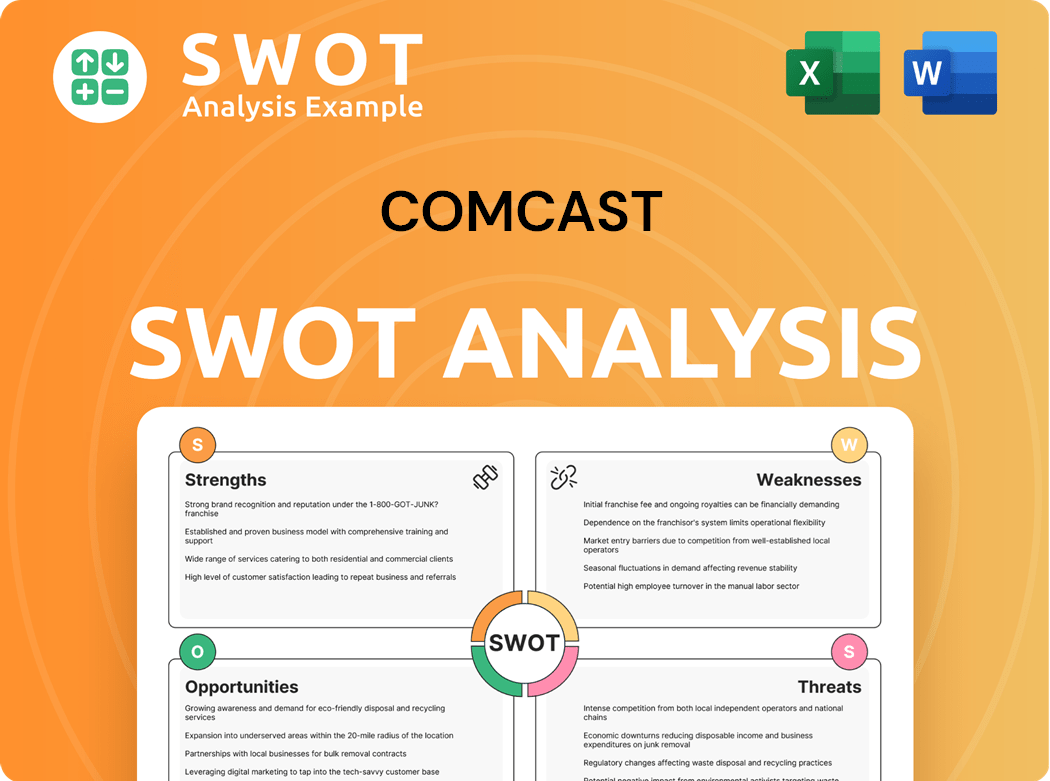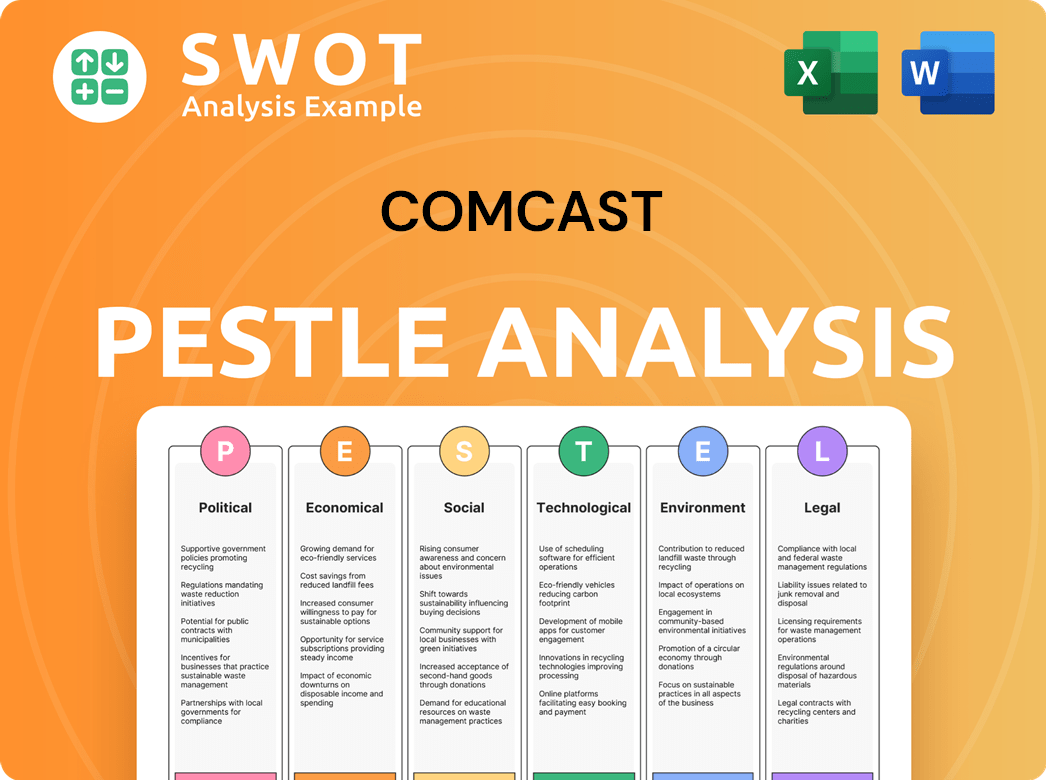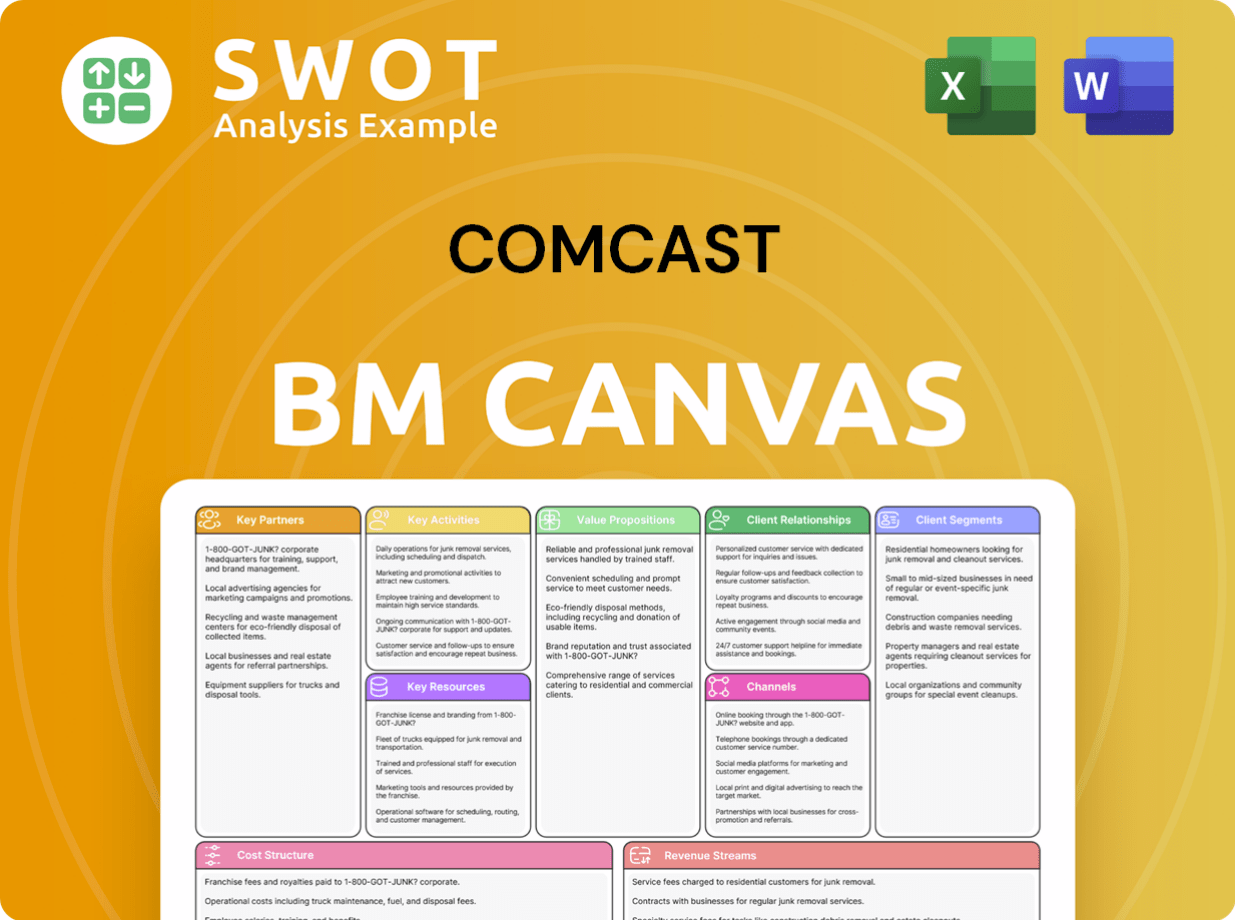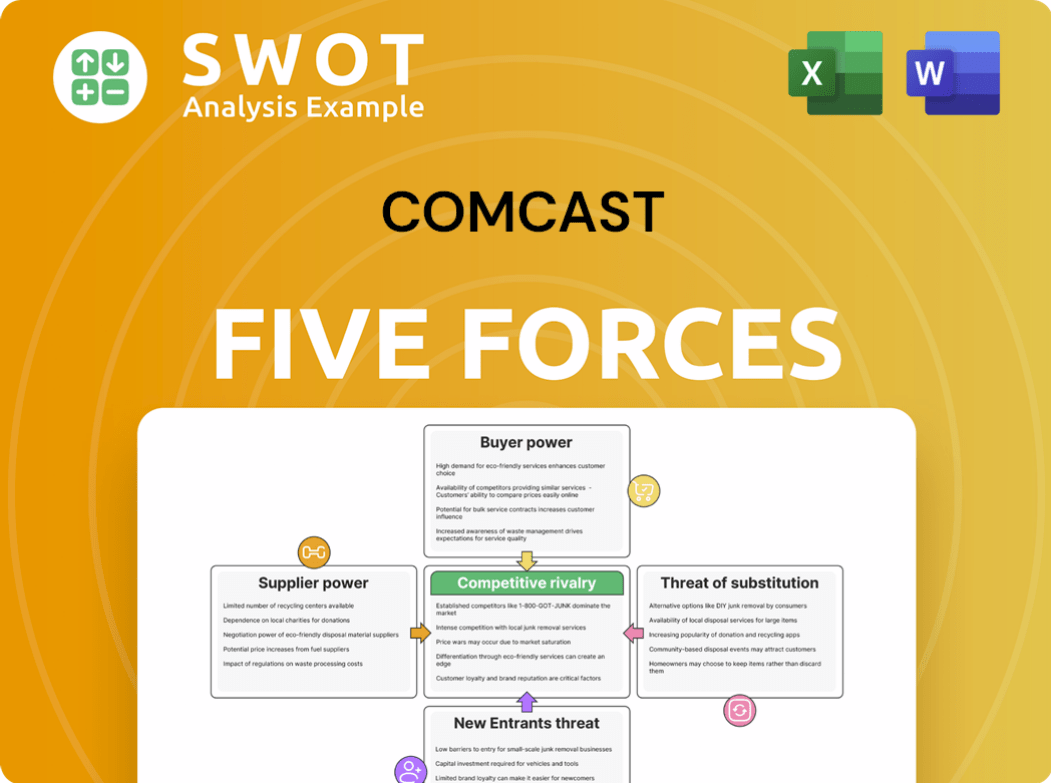Comcast Bundle
Decoding Comcast: How Does This Media Giant Really Work?
Comcast, a titan in the media and technology landscape, consistently shapes how we consume information and entertainment. Ranked among the world's largest companies, Comcast boasts a diverse portfolio spanning cable communications, broadband internet, television, and streaming services. With a reported $123.73 billion in revenue in 2024, understanding Comcast's inner workings is crucial for anyone navigating today's dynamic market.

From its Xfinity offerings to its NBCUniversal and Sky divisions, Comcast's reach is extensive. This deep dive will explore Comcast's core operations, revenue streams, and strategic advantages, offering a comprehensive look at the Comcast SWOT Analysis. Whether you're curious about how Comcast internet works, seeking information on Comcast services, or analyzing the company's future, this exploration will provide valuable insights into this influential Comcast business.
What Are the Key Operations Driving Comcast’s Success?
Comcast, a major player in the telecommunications industry, creates and delivers value through its extensive network infrastructure and a diverse range of services. These services primarily cater to residential and business customers, offering a bundle of communication and entertainment options. The company's core operations are centered around providing high-speed broadband internet, cable television, voice services, and mobile services under its Xfinity brand.
For business clients, Comcast Business provides connectivity solutions, including fixed broadband and mobile services, alongside advanced enterprise solutions. This comprehensive approach allows the company to serve various customer needs, from individual households to large corporations. Comcast continuously invests in technology development and infrastructure to maintain a competitive edge.
A significant aspect of Comcast's operational strategy involves continuous investment in technology development and infrastructure. The company has a robust network infrastructure that allows it to deliver gig-capable internet to 64 million homes and businesses. This extensive network is a major source of differentiation and a competitive advantage, enabling Comcast to provide reliable and fast services. In 2024, Comcast began offering prepaid domestic broadband services under the NOW brand, with speeds up to 200 megabits per second.
Comcast's vast network is a critical asset, enabling the delivery of high-speed internet and other services. This infrastructure allows the company to provide reliable and fast services to a large customer base. The ongoing investments in network upgrades ensure that Comcast remains competitive in the market.
Comcast's ability to bundle services, such as internet, TV, and voice, enhances its value proposition. Bundling provides convenience and potential cost savings for customers. This strategy helps to increase customer loyalty and reduce churn rates.
The integration of NBCUniversal into Comcast's operations offers a significant advantage. This integration allows for bundled service offerings, combining connectivity with compelling content, which appeals to consumers seeking convenience and value. This enhances the overall customer experience.
Comcast focuses on improving customer experience through enhanced customer service and simplified pricing models. These efforts aim to increase customer satisfaction and loyalty. The company's commitment to customer satisfaction is a key part of its strategy.
Comcast's value proposition is built on a strong network, bundled services, and content integration. This approach allows Comcast to offer a comprehensive suite of services that appeal to a broad customer base. The company's focus on customer experience further strengthens its market position.
- Extensive network infrastructure providing high-speed internet.
- Bundled services that combine internet, TV, and voice.
- Integration with NBCUniversal for compelling content offerings.
- Commitment to improving customer service and satisfaction.
- Strategic partnerships to expand service reach, such as the deal with Starlink.
Comcast's value proposition is further strengthened by its media and entertainment arm, NBCUniversal, which includes television networks (such as USA Network, CNBC, MSNBC), film studios, and theme parks. This integration allows for bundled service offerings, combining connectivity with compelling content, which appeals to consumers seeking convenience and value. The company's emphasis on customer experience, including initiatives like enhanced customer service and simplified pricing models, aims to increase customer satisfaction and loyalty. Partnerships, such as the 2024 deal with Starlink to provide satellite-based connectivity to business customers in areas with limited network access, also enhance its distribution networks and service reach. To understand more about the financial aspects of the company, you can learn more about Owners & Shareholders of Comcast.
Comcast SWOT Analysis
- Complete SWOT Breakdown
- Fully Customizable
- Editable in Excel & Word
- Professional Formatting
- Investor-Ready Format

How Does Comcast Make Money?
Comcast generates revenue through two primary segments: Connectivity & Platforms and Content & Experiences. In 2024, the company's total revenue reached $123.73 billion, reflecting a 1.78% increase compared to 2023.
The company employs various monetization strategies, including subscription fees, advertising revenue, and bundled services. Comcast also leverages technology solutions to generate revenue, expanding its reach in the market.
This chapter delves into the specific revenue streams and monetization strategies employed by Comcast, providing a detailed overview of its financial performance.
The Connectivity & Platforms segment is the largest revenue driver for Comcast. This segment includes residential broadband, video, voice, and wireless services, as well as business services connectivity. In fiscal year 2024, this segment generated $71.57 billion in revenue, accounting for 54.18% of the total revenue.
- Domestic broadband revenue increased in Q1 2024 due to higher average rates.
- Wireless services are a growing area, with 323,000 new customer lines added in Q1 2025, bringing the total to 8.15 million.
- Xfinity Mobile's revenue soared 16% to $1.12 billion in Q1 2025.
- Business Services Connectivity also contributes significantly, with revenue increasing due to growth from enterprise solutions and small business customers.
The Content & Experiences segment, primarily driven by NBCUniversal and Sky, contributed $45 billion in 2024, representing approximately 37% of total revenue. This segment includes revenue from media (television networks and Peacock streaming service), studios (film and television production), and theme parks.
- Peacock has shown significant growth, with paid subscribers surging to 41 million in Q1 2025, a 14% increase from Q1 2024, and its adjusted EBITDA jumped 21% to $1.0 billion in Q1 2025, narrowing its operating loss.
- In Q4 2024, Peacock's revenue increased 28% to $1.3 billion, with a 46% growth for the full year.
- Studios revenue increased 3% to $2.83 billion in Q1 2025, driven by content licensing.
- Theme Parks revenue in Q4 2024 was consistent with the prior year period.
Comcast utilizes various strategies to monetize its services and content. These include subscription fees for its broadband, video, and mobile services, as well as advertising revenue from its media properties. The company also offers bundled services, providing discounts to customers who subscribe to multiple Xfinity services.
- In 2024, Comcast Technology Solutions debuted its Cloud TV platform, a managed service that broadcasters and providers can license, transforming Comcast into a technology provider and monetizing its innovations globally.
- This platform supports various monetization models, including SVOD (Subscription Video On Demand), AVOD (Advertising Video On Demand), TVOD (Transactional Video On Demand), and FAST (Free Ad-Supported Streaming TV).
Comcast PESTLE Analysis
- Covers All 6 PESTLE Categories
- No Research Needed – Save Hours of Work
- Built by Experts, Trusted by Consultants
- Instant Download, Ready to Use
- 100% Editable, Fully Customizable

Which Strategic Decisions Have Shaped Comcast’s Business Model?
Comcast's journey has been marked by significant milestones and strategic moves that have shaped its operational and financial landscape. The company has evolved from a cable company to a diversified media and technology giant, constantly adapting to the changing media landscape. A pivotal shift has been the company's aggressive expansion into streaming and wireless services, aiming to offset declines in traditional cable subscriptions.
Comcast's strategic moves include significant investments in its broadband infrastructure and a focus on content creation and distribution through NBCUniversal. These initiatives are designed to enhance customer experience and drive revenue growth. Furthermore, Comcast leverages its extensive network to compete in the wireless market with a low-cost, no-contract model.
The company's competitive edge lies in its extensive network infrastructure, strong brand recognition, and diverse service offerings. Comcast continues to adapt by focusing on digital transformation, global expansion of Peacock, and strategic partnerships. Its ability to bundle services and its investments in advanced technologies provide a differentiated service.
Comcast has experienced several key milestones, including the acquisition of NBCUniversal and the launch of its streaming service, Peacock. Comcast's expansion into wireless services with Xfinity Mobile represents another major step. These moves have transformed Comcast into a media and technology leader.
Comcast's strategic moves include the expansion of Xfinity Mobile, which added 323,000 new customer lines in Q1 2025, reaching 8.15 million total lines. The company is also enhancing its broadband offerings, with plans to add 1.2 million homes to its network in 2025. Comcast is also focusing on the expansion of its streaming platform, Peacock.
Comcast's competitive advantages include its extensive network infrastructure, strong brand recognition, and diverse service offerings. The company's ability to bundle services and its investments in advanced technologies provide a differentiated service. Comcast's ownership of NBCUniversal also provides a unique competitive edge.
Peacock's paid subscribers surged to 41 million in Q1 2025, a 14% increase from Q1 2024, and its adjusted EBITDA jumped 21% to $1.0 billion in Q1 2025. In Q1 2025, Comcast reported a loss of 199,000 domestic broadband customers. The upcoming opening of Universal Epic Universe in Orlando in May 2025 is expected to be a significant growth driver.
Comcast faces challenges such as cord-cutting and competition in the broadband market. However, the company has significant opportunities for growth through its streaming service, wireless offerings, and theme parks. Comcast continues to adapt by focusing on digital transformation, global expansion of Peacock, and strategic partnerships.
- The ongoing trend of cord-cutting and intense competition in the broadband market.
- Expansion of Xfinity Mobile and broadband offerings.
- Growth of Peacock and its premium content.
- Upcoming opening of Universal Epic Universe in Orlando.
Comcast Business Model Canvas
- Complete 9-Block Business Model Canvas
- Effortlessly Communicate Your Business Strategy
- Investor-Ready BMC Format
- 100% Editable and Customizable
- Clear and Structured Layout

How Is Comcast Positioning Itself for Continued Success?
As a leading global media and technology company, Comcast holds a significant industry position, especially in the United States. In fiscal year 2024, the U.S. market accounted for a substantial 77.78% of its total revenue. The company benefits from a strong network infrastructure and a diverse range of services, including cable, internet, and phone, which contributes to its competitive advantage.
However, Comcast faces various challenges, including cord-cutting trends that impact its video subscriber base. Intense competition in the broadband market also contributes to customer losses. Macroeconomic uncertainties and the performance of its streaming service, Peacock, also pose risks. Understanding the Competitors Landscape of Comcast is crucial for investors and stakeholders.
Comcast is a major player in the media and technology sector, particularly in the U.S. Its extensive network and diverse offerings give it a strong competitive edge. The company's focus on cable, internet, and phone services solidifies its market presence.
Comcast faces risks like the decline in traditional video subscribers and intense broadband competition. Economic uncertainties and the performance of Peacock are also significant concerns. In Q1 2025, Comcast lost 427,000 domestic video customers.
Comcast is focusing on digital transformation, Peacock's expansion, and Xfinity Mobile growth. The company aims to stabilize broadband ARPU with premium services and has a focus on business services. The opening of Universal Epic Universe in May 2025 is a key strategic move.
Analysts project revenue growth of 1.56% and EPS growth of 8.32% for Comcast. In Q1 2025, Comcast returned $3.2 billion to shareholders. The company's strong cash flow and disciplined capital allocation support its future prospects.
Comcast is implementing several strategic initiatives to drive future growth and navigate industry challenges. These initiatives are designed to leverage existing strengths and capitalize on emerging opportunities within the media and technology landscape.
- Peacock Expansion: Investing in Peacock's global expansion, original content, and strategic partnerships.
- Xfinity Mobile Growth: Amplifying Xfinity Mobile's growth through 5G investments and bundled offerings with broadband services.
- Broadband ARPU Stabilization: Focusing on premium services like ultra-fast internet plans and a new five-year nationwide price guarantee for broadband.
- Business Services Expansion: Expanding business services, which saw mid-single-digit revenue and EBITDA growth in Q1 2025.
- Theme Park Development: The grand opening of Universal Epic Universe in Orlando in May 2025 is a significant strategic move.
Comcast Porter's Five Forces Analysis
- Covers All 5 Competitive Forces in Detail
- Structured for Consultants, Students, and Founders
- 100% Editable in Microsoft Word & Excel
- Instant Digital Download – Use Immediately
- Compatible with Mac & PC – Fully Unlocked

Related Blogs
- What are Mission Vision & Core Values of Comcast Company?
- What is Competitive Landscape of Comcast Company?
- What is Growth Strategy and Future Prospects of Comcast Company?
- What is Sales and Marketing Strategy of Comcast Company?
- What is Brief History of Comcast Company?
- Who Owns Comcast Company?
- What is Customer Demographics and Target Market of Comcast Company?
Disclaimer
All information, articles, and product details provided on this website are for general informational and educational purposes only. We do not claim any ownership over, nor do we intend to infringe upon, any trademarks, copyrights, logos, brand names, or other intellectual property mentioned or depicted on this site. Such intellectual property remains the property of its respective owners, and any references here are made solely for identification or informational purposes, without implying any affiliation, endorsement, or partnership.
We make no representations or warranties, express or implied, regarding the accuracy, completeness, or suitability of any content or products presented. Nothing on this website should be construed as legal, tax, investment, financial, medical, or other professional advice. In addition, no part of this site—including articles or product references—constitutes a solicitation, recommendation, endorsement, advertisement, or offer to buy or sell any securities, franchises, or other financial instruments, particularly in jurisdictions where such activity would be unlawful.
All content is of a general nature and may not address the specific circumstances of any individual or entity. It is not a substitute for professional advice or services. Any actions you take based on the information provided here are strictly at your own risk. You accept full responsibility for any decisions or outcomes arising from your use of this website and agree to release us from any liability in connection with your use of, or reliance upon, the content or products found herein.